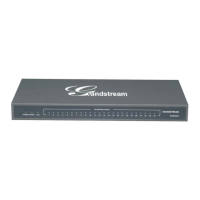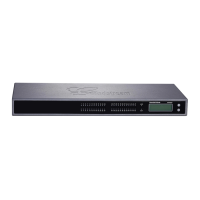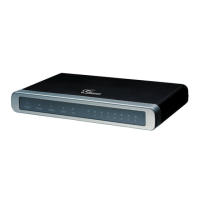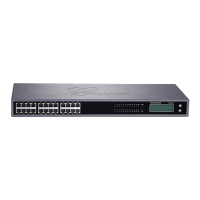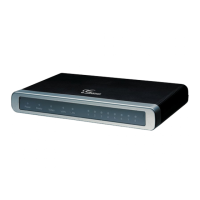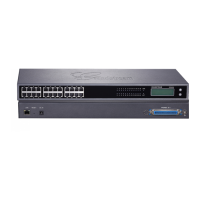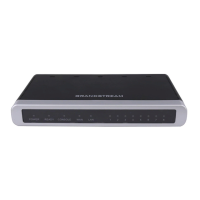
Do you have a question about the Grandstream Networks GXW-4004 and is the answer not in the manual?
| FXO Ports | 4 |
|---|---|
| Ethernet Ports | 1 |
| Humidity | 10% to 90% non-condensing |
| Ports | 4 |
| Network Interface | 10/100 Mbps Ethernet |
| Protocols | SIP |
| Voice Codecs | G.711, G.723.1, G.729 A/B |
| Fax over IP | T.38 |
| Operating Temperature | 0 to 40°C |
Provides an overview of the GXW40XX series, highlighting its design, features, and capabilities.
Details compliance with safety standards like FCC/CE and warnings regarding power adapters.
Explains warranty terms and how end users should contact the seller for issues.
Lists the accessories included in the GXW40XX package for setup.
Provides step-by-step instructions for connecting the GXW40XX gateway to the network.
Details the comprehensive software capabilities, including codecs, fax, and call features.
Presents a detailed table comparing hardware specifications across GXW4004, GXW4008, and GXW4024 models.
Explains how to navigate and use the device's voice prompt menu for configuration.
Describes how to dial standard phone or extension numbers on the GXW40XX.
Explains how to make direct IP calls between devices without a SIP proxy.
Details how to place and resume calls on hold using the flash button.
Explains how to handle incoming calls while on an active call.
Introduces the concept of transferring calls.
Describes the procedure for transferring a call without speaking to the recipient first.
Explains how to transfer a call after speaking to the recipient.
Details how to set up and manage three-way conference calls.
Illustrates how to configure a typical hunting group setup for call distribution.
Shows how to configure multiple, non-sequential hunting groups for advanced call routing.
Explains the PSTN pass-through feature for analog phones during power loss.
Describes the methods and settings for sending and receiving faxes via the gateway.
Guides users on configuring the gateway using its built-in voice prompt menu.
Explains how to access and use the web interface for gateway configuration.
Highlights essential settings that end-users must configure based on their environment.
Provides detailed steps to access the gateway's configuration menu via LAN or WAN ports.
Covers network address translation settings, recommending STUN server usage for firewalled networks.
Explains the different DTMF methods (in-audio, RTP, SIP INFO) and their priority settings.
Lists supported voice codecs and how to configure their preferred order.
Defines terms and user interface options available for end-users and administrators.
Covers fundamental preferences like date, time, multi-purpose keys, and LCD settings.
Specifies the client name for DHCP, optional but sometimes required by ISPs.
Controls how date/time is displayed based on the specified time zone and DST rules.
Controls whether the device operates in NAT router mode or Bridge mode.
Sets the NAT UDP timeout in seconds.
Enables the gateway to act as an UPnP gateway for UPnP-enabled applications.
Controls access to configuration pages via the WAN port, noting security implications.
Enables or disables the DHCP server for the LAN.
Sets the duration (in hours) that an IP address is assigned to LAN clients.
Displays network status, account status, software version, and MAC address.
Provides access to advanced network, codec, and XML configuration settings.
Sets the administrator password for accessing advanced configuration settings.
Configures the layer 3 QoS parameter for IP Precedence or Diff-Serv/MPLS.
Specifies the IP address or domain name of the STUN server for NAT traversal.
Enables downloading firmware or configuration files using TFTP or HTTP/S.
Configures the IP address of the TFTP server for firmware and configuration file downloads.
Specifies the URL of the HTTP server used for firmware upgrade and configuration.
Allows setting prefixes and postfixes for firmware/config files for easier management.
Enables automatic firmware and provisioning upgrades based on a schedule.
Configures the SSL certificate for securing SIP over TLS communication.
Specifies the password for the Auto Configuration Server (ACS).
Configures the ring cadence pattern for incoming calls on FXS ports.
Allows configuration of tone frequencies for dial tone, ringback, etc.
Disables the voice prompt configuration, making the integrated voice menu inaccessible.
Ensures PSTN call capability during power loss or SIP registration failure.
Routes outbound calls to an FXO gateway if SIP registration is lost.
Specifies the Network Time Protocol server for synchronizing date and time.
Selects the log level (DEBUG, INFO, WARNING, ERROR) for reporting device events.
Configures the IP address or FQDN of the primary RADIUS server for authentication.
Identifies the specific FXS port being configured.
User account information provided by the VoIP service provider for SIP registration.
The SIP subscriber's authentication ID, used for registering with SIP servers.
Enables gateway registration of FXS ports with the same phone number for call distribution.
Activates or deactivates an FXS port, with 'Yes' being the default.
Activates or deactivates a specific SIP profile for gateway configuration.
Specifies the IP address or domain name of the primary SIP server.
Provides a backup SIP server address if the primary server becomes unavailable.
Configures how the gateway resolves IP addresses for domain names (A Record, SRV, etc.).
Controls whether the GXW40XX sends REGISTER messages to the proxy server.
Determines if SIP registration information is cleared when the device reboots.
Defines the local SIP port the GXW40XX listens on for profile configurations.
Validates incoming SIP messages against RFC rules; rejects invalid ones.
Configures the priority order for DTMF methods: in-audio, RTP, or SIP Info.
Allows custom ring tones based on Caller ID matching.
Enables/disables the visual message waiting indicator (MWI) on phones.
Sets the call distribution style for hunting groups (Linear or Circular).
Sets the time interval for completing a call if no additional key entry occurs.
Defines the grammar and syntax for creating dial plan rules for outgoing calls.
Sets the time limit for SIP sessions before they are considered timed out.
Enables session timer for outbound calls if the remote party supports it.
Sends an INVITE with audio vocoders after fax completion to resume audio session.
Allows users to configure a preference list for voice codecs (G.711, G.726, etc.).
Changes RTP packet destination to source IP/port of last received inbound packet.
Selects between T.38 (FoIP) or Pass-Through mode for fax transmission.
Configures Secure Real-time Transport Protocol mode (Disabled, Enabled, Forced).
Details the process of upgrading firmware using TFTP, HTTP, or HTTPS protocols.
Provides step-by-step instructions for performing firmware upgrades locally.
Explains how to download configuration files via Web Interface or TFTP/HTTP/HTTPS.
Allows setting prefixes and postfixes for firmware/config files for easier management.
Configures automatic upgrade schedules and download checks.
Details the methods for performing a factory reset to restore default settings.
Explains how to use the physical reset button to restore factory default settings.
Describes how to reset the device to factory defaults using the IVR prompt.
